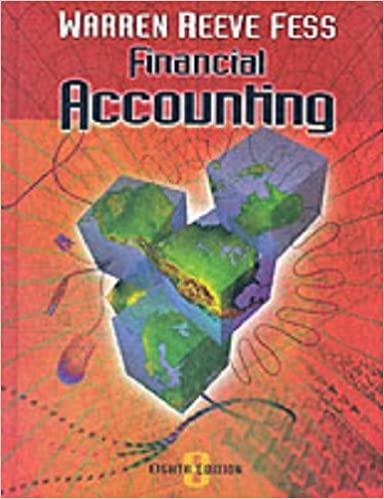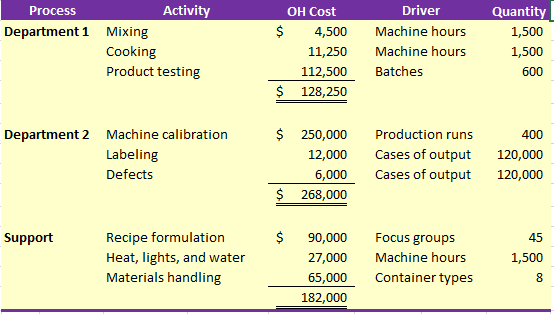
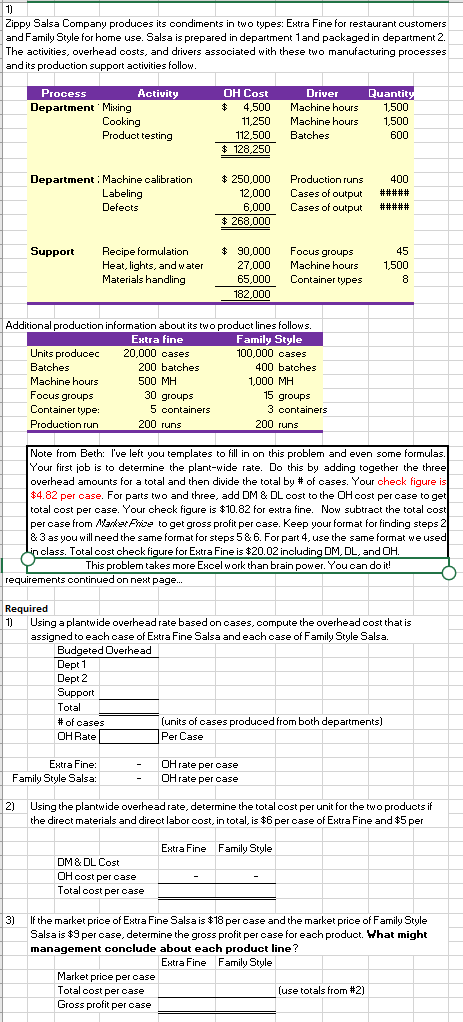
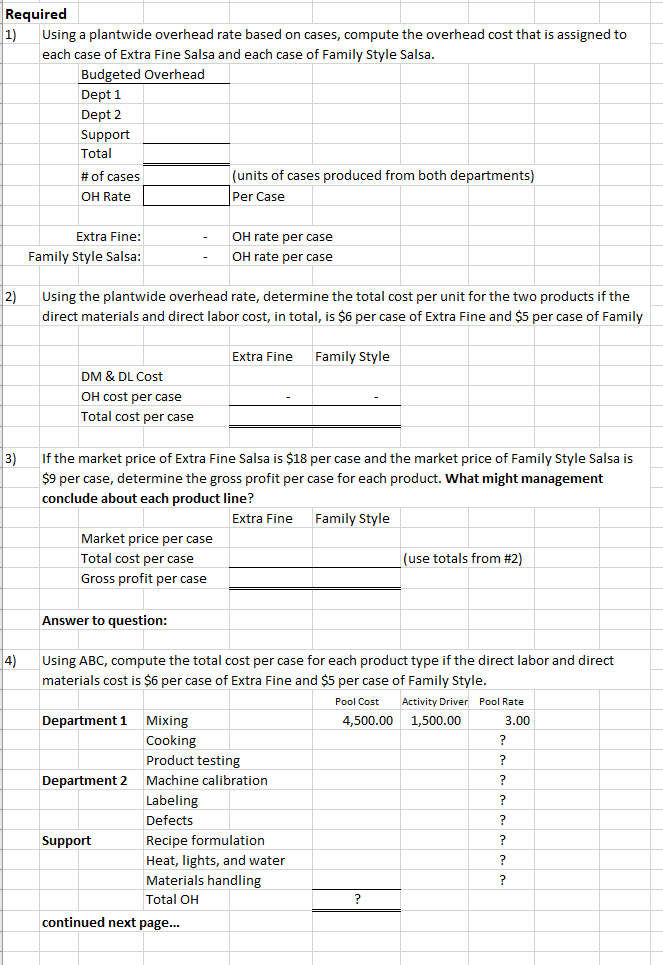
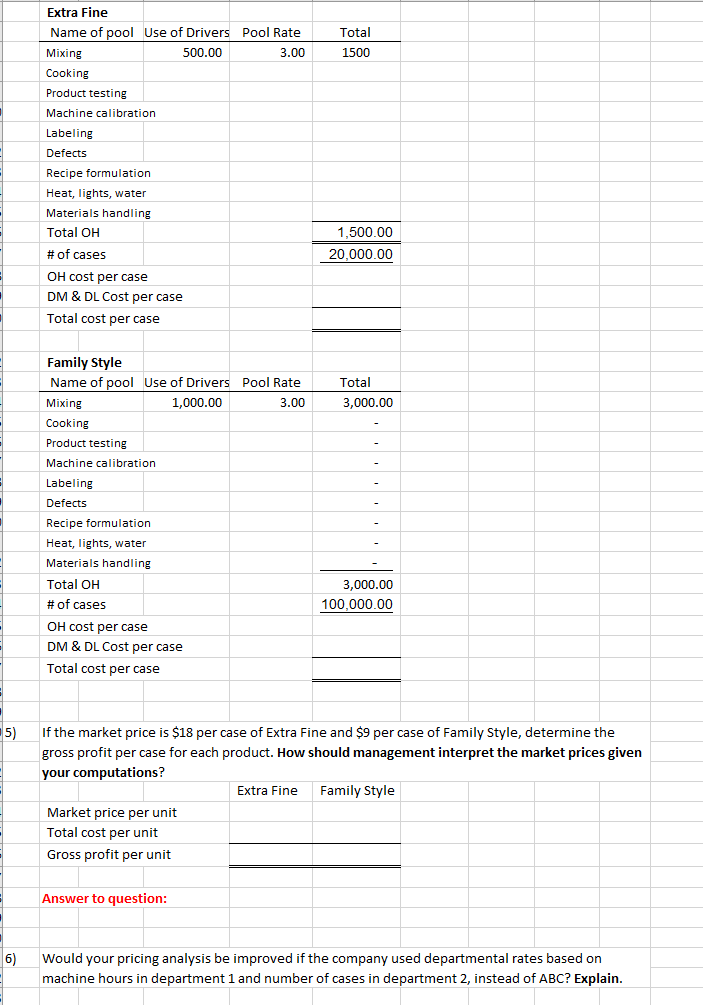 need help with all questions through 6. dont understand
need help with all questions through 6. dont understand
Process Activity Department 1 Mixing Cooking Product testing OH Cost $ 4,500 11,250 112,500 $ 128,250 Driver Machine hours Machine hours Batches Quantity 1,500 1,500 600 $ Department 2 Machine calibration Labeling Defects 250,000 12,000 Production runs cases of output Cases of output 400 120,000 120,000 $ 268,000 Support $ 45 Recipe formulation Heat, lights, and water Materials handling 90,000 27,000 65,000 182,000 Focus groups Machine hours Container types 1,500 1) Zippy Salsa Company produces its condiments in two types: Extra Fine for restaurant customers and Family Style for home use. Salsa is prepared in department 1 and packaged in department 2 The activities, overhead costs, and drivers associated with these two manufacturing processes and its production support activities follow. Process Activity Department' Mixing Cooking Product testing OH Cost $ 4,500 11,250 112,500 $ 128,250 Driver Machine hours Machine hours Batches Quantity 1,500 1,500 600 Department: Machine calibration Labeling Defects $ 250,000 12,000 6,000 $ 268,000 Production runs Cases of output Cases of output 400 ##### ##### Support $ Recipe formulation Heat, lights, and water Materials handling 90,000 27,000 65,000 182,000 Focus groups Machine hours Container types 45 1,500 8 Additional production information about its two product lines follows. Extra fine Family Style Units producec 20,000 cases 100,000 cases Batches 200 batches 400 batches Machine hours 500 MH 1,000 MH Focus groups 30 groups 15 groups Container type: 5 containers 3 containers Production run 200 runs 200 runs Note from Beth: I've left you templates to fill in on this problem and even some formulas Your first job is to determine the plant-wide rate. Do this by adding together the three overhead amounts for a total and then divide the total by # of cases. Your cheok figure is $4.82 per case. For parts two and three, add DM & DL cost to the OH cost per case to get total cost per case. Your check figure is $10.82 for extra fine. Now subtract the total cost per case from Mankwere to get gross profit per case. Keep your format for finding steps 2 & 3 as you will need the same format for steps 5 & 6. For part 4, use the same format we used in class. Total cost check figure for Extra Fine is $20.02 inoluding DM, DL, and OH. This problem takes more Excel work than brain power. You can do it! requirements continued on next page... Required 1) Using a plantwide overhead rate based on cases, compute the overhead cost that is assigned to each case of Extra Fine Salsa and each case of Family Style Salsa Budgeted Overhead Dept 1 Dept 2 Support Total #of cases (units of cases produced from both departments) OH Rate Per Case - Extra Fine: Family Style Salsa: OH rate per case OH rate per case 12) Using the plantwide overhead rate, determine the total cost per unit for the two products if the direct materials and direct labor cost in total, is $6 per case of Extra Fine and $5 per Extra Fine Family Style DM & DL Cost OH cost per case Total cost per case - - 13) If the market price of Extra Fine Salsa is $18 per case and the market price of Family Style Salsa is $9 per case, determine the gross profit per case for each product. What might management conclude about each product line? Extra Fine Family Style Market price per case Total cost per case (use totals from #2) Gross profit per case Required 1) Using a plantwide overhead rate based on cases, compute the overhead cost that is assigned to each case of Extra Fine Salsa and each case of Family Style Salsa. Budgeted Overhead Dept 1 Dept 2 Support Total # of cases (units of cases produced from both departments) OH Rate Per Case Extra Fine: Family Style Salsa: OH rate per case OH rate per case - 2) Using the plantwide overhead rate, determine the total cost per unit for the two products if the direct materials and direct labor cost, in total, is $6 per case of Extra Fine and $5 per case of Family Extra Fine Family Style DM & DL Cost OH cost per case Total cost per case 3) If the market price of Extra Fine Salsa is $18 per case and the market price of Family Style Salsa is $9 per case, determine the gross profit per case for each product. What might management conclude about each product line? Extra Fine Family Style Market price per case Total cost per case (use totals from #2) Gross profit per case Answer to question: Using ABC, compute the total cost per case for each product type if the direct labor and direct materials cost is $6 per case of Extra Fine and $5 per case of Family Style. Pool Cost Activity Driver Pool Rate Department 1 Mixing 4,500.00 1,500.00 3.00 Cooking Product testing Department 2 Machine calibration Labeling Defects Support Recipe formulation Heat, lights, and water Materials handling Total OH continued next page... Total 1500 Extra Fine Name of pool Use of Drivers Pool Rate Mixing 500.00 3.00 Cooking Product testing Machine calibration Labeling Defects Recipe formulation Heat, lights, water Materials handling Total OH # of cases OH cost per case DM & DL Cost per case Total cost per case 1,500.00 20,000.00 Total 3,000.00 Family Style Name of pool Use of Drivers Pool Rate Mixing 1,000.00 3.00 Cooking Product testing Machine calibration Labeling Defects Recipe formulation Heat, lights, water Materials handling Total OH #of cases OH cost per case DM & DL Cost per case Total cost per case 3,000.00 100,000.00 If the market price is $18 per case of Extra Fine and $9 per case of Family Style, determine the gross profit per case for each product. How should management interpret the market prices given your computations? Extra Fine Family Style Market price per unit Total cost per unit Gross profit per unit Answer to question: 6) Would your pricing analysis be improved if the company used departmental rates based on machine hours in department 1 and number of cases in department 2, instead of ABC? Explain. Process Activity Department 1 Mixing Cooking Product testing OH Cost $ 4,500 11,250 112,500 $ 128,250 Driver Machine hours Machine hours Batches Quantity 1,500 1,500 600 $ Department 2 Machine calibration Labeling Defects 250,000 12,000 Production runs cases of output Cases of output 400 120,000 120,000 $ 268,000 Support $ 45 Recipe formulation Heat, lights, and water Materials handling 90,000 27,000 65,000 182,000 Focus groups Machine hours Container types 1,500 1) Zippy Salsa Company produces its condiments in two types: Extra Fine for restaurant customers and Family Style for home use. Salsa is prepared in department 1 and packaged in department 2 The activities, overhead costs, and drivers associated with these two manufacturing processes and its production support activities follow. Process Activity Department' Mixing Cooking Product testing OH Cost $ 4,500 11,250 112,500 $ 128,250 Driver Machine hours Machine hours Batches Quantity 1,500 1,500 600 Department: Machine calibration Labeling Defects $ 250,000 12,000 6,000 $ 268,000 Production runs Cases of output Cases of output 400 ##### ##### Support $ Recipe formulation Heat, lights, and water Materials handling 90,000 27,000 65,000 182,000 Focus groups Machine hours Container types 45 1,500 8 Additional production information about its two product lines follows. Extra fine Family Style Units producec 20,000 cases 100,000 cases Batches 200 batches 400 batches Machine hours 500 MH 1,000 MH Focus groups 30 groups 15 groups Container type: 5 containers 3 containers Production run 200 runs 200 runs Note from Beth: I've left you templates to fill in on this problem and even some formulas Your first job is to determine the plant-wide rate. Do this by adding together the three overhead amounts for a total and then divide the total by # of cases. Your cheok figure is $4.82 per case. For parts two and three, add DM & DL cost to the OH cost per case to get total cost per case. Your check figure is $10.82 for extra fine. Now subtract the total cost per case from Mankwere to get gross profit per case. Keep your format for finding steps 2 & 3 as you will need the same format for steps 5 & 6. For part 4, use the same format we used in class. Total cost check figure for Extra Fine is $20.02 inoluding DM, DL, and OH. This problem takes more Excel work than brain power. You can do it! requirements continued on next page... Required 1) Using a plantwide overhead rate based on cases, compute the overhead cost that is assigned to each case of Extra Fine Salsa and each case of Family Style Salsa Budgeted Overhead Dept 1 Dept 2 Support Total #of cases (units of cases produced from both departments) OH Rate Per Case - Extra Fine: Family Style Salsa: OH rate per case OH rate per case 12) Using the plantwide overhead rate, determine the total cost per unit for the two products if the direct materials and direct labor cost in total, is $6 per case of Extra Fine and $5 per Extra Fine Family Style DM & DL Cost OH cost per case Total cost per case - - 13) If the market price of Extra Fine Salsa is $18 per case and the market price of Family Style Salsa is $9 per case, determine the gross profit per case for each product. What might management conclude about each product line? Extra Fine Family Style Market price per case Total cost per case (use totals from #2) Gross profit per case Required 1) Using a plantwide overhead rate based on cases, compute the overhead cost that is assigned to each case of Extra Fine Salsa and each case of Family Style Salsa. Budgeted Overhead Dept 1 Dept 2 Support Total # of cases (units of cases produced from both departments) OH Rate Per Case Extra Fine: Family Style Salsa: OH rate per case OH rate per case - 2) Using the plantwide overhead rate, determine the total cost per unit for the two products if the direct materials and direct labor cost, in total, is $6 per case of Extra Fine and $5 per case of Family Extra Fine Family Style DM & DL Cost OH cost per case Total cost per case 3) If the market price of Extra Fine Salsa is $18 per case and the market price of Family Style Salsa is $9 per case, determine the gross profit per case for each product. What might management conclude about each product line? Extra Fine Family Style Market price per case Total cost per case (use totals from #2) Gross profit per case Answer to question: Using ABC, compute the total cost per case for each product type if the direct labor and direct materials cost is $6 per case of Extra Fine and $5 per case of Family Style. Pool Cost Activity Driver Pool Rate Department 1 Mixing 4,500.00 1,500.00 3.00 Cooking Product testing Department 2 Machine calibration Labeling Defects Support Recipe formulation Heat, lights, and water Materials handling Total OH continued next page... Total 1500 Extra Fine Name of pool Use of Drivers Pool Rate Mixing 500.00 3.00 Cooking Product testing Machine calibration Labeling Defects Recipe formulation Heat, lights, water Materials handling Total OH # of cases OH cost per case DM & DL Cost per case Total cost per case 1,500.00 20,000.00 Total 3,000.00 Family Style Name of pool Use of Drivers Pool Rate Mixing 1,000.00 3.00 Cooking Product testing Machine calibration Labeling Defects Recipe formulation Heat, lights, water Materials handling Total OH #of cases OH cost per case DM & DL Cost per case Total cost per case 3,000.00 100,000.00 If the market price is $18 per case of Extra Fine and $9 per case of Family Style, determine the gross profit per case for each product. How should management interpret the market prices given your computations? Extra Fine Family Style Market price per unit Total cost per unit Gross profit per unit Answer to question: 6) Would your pricing analysis be improved if the company used departmental rates based on machine hours in department 1 and number of cases in department 2, instead of ABC? Explain



 need help with all questions through 6. dont understand
need help with all questions through 6. dont understand





